|
|
 |
|
|
 |
 Perhaps no sound more clearly evokes an image of wildness than the honking of migrating geese. It is hard for us to believe
that some 80 years ago, the Canada goose was thought to be nearly extinct!
Perhaps no sound more clearly evokes an image of wildness than the honking of migrating geese. It is hard for us to believe
that some 80 years ago, the Canada goose was thought to be nearly extinct!
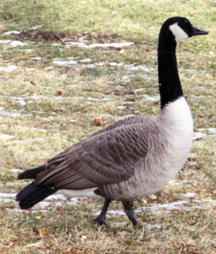 Canada geese are large birds, averaging 10-14 pounds. Among waterfowl (ducks, geese and swans) of North America, Canada geese
are second only to swans in size. Geese form permanent pair bonds, but if one bird dies, the other will seek a mate in the
next breeding season. Most Canada geese don’t begin nesting until they are three, but make up for it by being long lived.
Adult females lay 4-6 eggs in a clutch. If the clutch is destroyed, geese generally don’t re-nest, but with two large
birds guarding a nest, the chances of success are good. Usually by the time the young are 4-6 weeks old, the broods begin
gathering into one large flock. Non-breeders and yearlings form separate flocks. By fall, they all gather into one large flock.
Canada geese have passed through Colorado on their journeys to and from their artic breeding grounds for centuries. But it
was unusual for them to spend much time here. Yet today in Colorado you can find Canada Geese any time of the year. In some
areas there are too many geese! Why the change?
Canada geese are large birds, averaging 10-14 pounds. Among waterfowl (ducks, geese and swans) of North America, Canada geese
are second only to swans in size. Geese form permanent pair bonds, but if one bird dies, the other will seek a mate in the
next breeding season. Most Canada geese don’t begin nesting until they are three, but make up for it by being long lived.
Adult females lay 4-6 eggs in a clutch. If the clutch is destroyed, geese generally don’t re-nest, but with two large
birds guarding a nest, the chances of success are good. Usually by the time the young are 4-6 weeks old, the broods begin
gathering into one large flock. Non-breeders and yearlings form separate flocks. By fall, they all gather into one large flock.
Canada geese have passed through Colorado on their journeys to and from their artic breeding grounds for centuries. But it
was unusual for them to spend much time here. Yet today in Colorado you can find Canada Geese any time of the year. In some
areas there are too many geese! Why the change?
The comeback from near-extinction of the giant Canada goose (Branta canadensis maxima), is one of the great wildlife success
stories of the 20th century. That it went terribly awry late in the century is an irony pioneering conservationists couldn’t
have thought of, anymore than they could have thought of suburbs.
In contrast, few people today can conceive of the desperation early conservationists felt in the face of the rapacious slaughter
of wildlife after the Civil War and into
the 20th century. It was called the “age of extermination.”
Robins were routinely killed and eaten back then. People collected and ate songbird eggs, too. A huge market for wild-bird
feathers, sold to hat makers, thrived world-wide. At the London Millinery Feather Market’s quarterly sale in August
of 1912, the feathered skins of 1,600 hummingbirds, bound for bonnets, sold for two cents each.
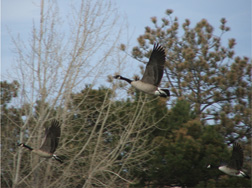 Just as the great herds of American bison were killed for commercial gain, all wildlife was the booty of professional hunters
who killed year-round without limits on what they could sell. Butcher shops were full of birds and animals shot or netted
by hunters. Wild birds were killed out.
Just as the great herds of American bison were killed for commercial gain, all wildlife was the booty of professional hunters
who killed year-round without limits on what they could sell. Butcher shops were full of birds and animals shot or netted
by hunters. Wild birds were killed out.
The Labrador duck became extinct in the 1870s and the passenger pigeon, netted and sold as squab, soon would be too. (The
last one died in the Cincinnati zoo in 1914).
“Of all the meat-shooters, the market-gunners who prey on wild fowl and ground game birds for the big-city markets are
the most deadly to wildlife,” wrote William T. Hornaday, director of the New York Zoological Park, in 1913. “Enough
geese, ducks, quail, ruffed grouse, prairie chickens, heath hens and wild pigeons have been butchered by gunners and netters
for ‘the market’ to have stocked the whole world.”
Stopping this carnage was the first triumph of the American conservation movement. It took decades. In 1878, Iowa adopted
the first bag-limit law, restricting shooters to 25 prairie chickens per day. In 1900, the first Federal conservation law,
the Lacey Act, prohibited interstate commerce in illegally-killed game. In 1901, Oregon limited hunters to 100 ducks per week.
Enforce-ment, however, was rare.
In 1916, the U.S. and Great Britain (on behalf of Canada) signed the Migratory Bird Treaty, to regulate commerce in wild birds.
Legislation implementing it passed two years later. But by the 1920s, some six million recreational hunters had become as
much of a threat to wild fowl as professional hunters were before. In 1930, the giant Canada goose, which had been relatively
easy to hunt, was widely believed extinct in the wild.
Bringing the Canada Geese back became an urgent quest.
Something crucial happened in 1935: Live decoys were outlawed. These were wounded or caught birds, used by hunters to lure
wild birds into gunning range. Decoys were held captive by cutting a wingtip or clipping feathers so they couldn’t fly.
Decoy flocks held some of the last giant Canada geese in existence.
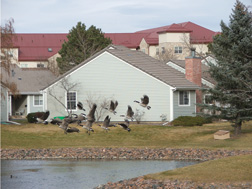 When live decoys were outlawed, hunters got rid of tens of thousands of the birds. Wildlife agencies took some, to help restock
wild populations. But many settled in local communities. Some towns wanted the geese for park ornaments, like peacocks. Farmers
took and raised others. The geese embraced human habitats and handouts. When America’s suburbs sprouted after World
War II, “resident” geese soon moved in. With plenty of food and protection from predators and hunters, they thrived.
When live decoys were outlawed, hunters got rid of tens of thousands of the birds. Wildlife agencies took some, to help restock
wild populations. But many settled in local communities. Some towns wanted the geese for park ornaments, like peacocks. Farmers
took and raised others. The geese embraced human habitats and handouts. When America’s suburbs sprouted after World
War II, “resident” geese soon moved in. With plenty of food and protection from predators and hunters, they thrived.
From then until the 1980s, federal agents rounded up “nuisance geese” in the suburbs, and relocated them to other
states, where they were wanted for hunting. In 1982, an avian influenza outbreak brought relocations to a halt. Goose populations
soared. By the time relocations were allowed again, Colorado was able to relocate geese within Colorado up to a few years
ago, but now, no one wants more.
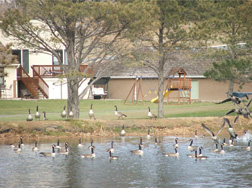 Nonmigrating geese are multiplying fastest on the East Coast, says the Fish and Wildlife Service, at an average rate of 14%
a year since 1989. Nonmigrating geese now outnumber wild, migrating geese along the Atlantic Flyway, the agency says.
Nonmigrating geese are multiplying fastest on the East Coast, says the Fish and Wildlife Service, at an average rate of 14%
a year since 1989. Nonmigrating geese now outnumber wild, migrating geese along the Atlantic Flyway, the agency says.
Colorado lies in the Central Flyway. The Central Flyway is an administrative unit for migratory game bird management. It is
comprised of ten states (MT, WY, CO, NM, TX, OK, KS, NE, SD & ND), two Canadian Provinces (Saskatchewan & Alberta), the Northwest
Territories and Nunavut.
In the decade of the 1960’s, winter counts of all Canada geese in the Central Flyway (CF) averaged about 220,000. The
average winter count between 1995 – 2005 was about 1.5 million, an increase of nearly 600 percent. The percent of the
total population of Canada geese in the CF from the Great Plains Population, which is the name given by the CF to restoration
birds, changed from about 5% to about 20% during a time when all Canada goose populations were increasing. In 1970, there
were twice as many migratory geese as resident geese. Now resident geese outnumber the migratory geese by about 26%.
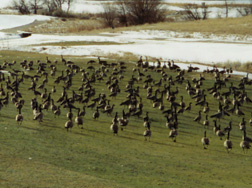
Source:
“Canadian Geese, Living With Wildlife,” Canada Geese in Massachusetts
Webster Lake Association
www.websterlakeassociation.com
New Goose Recipe: U.S. Plans To Ease Culling of 'Residents' Geese That 'Don't Know Where Canada Is' Could Face Early Demise
in U.S. Suburbs
By James P. Sterba
Staff Reporter of THE WALL STREET JOURNAL
“Balancing the needs of wildlife with the needs of people.”
www.masswildlife.org
Living With Wildlife
Canada Geese in Massachusetts
Historical Info and Range of Canada Geese
 Perhaps no sound more clearly evokes an image of wildness than the honking of migrating geese. It is hard for us to believe
that some 80 years ago, the Canada goose was thought to be nearly extinct!
Perhaps no sound more clearly evokes an image of wildness than the honking of migrating geese. It is hard for us to believe
that some 80 years ago, the Canada goose was thought to be nearly extinct!
 Canada geese are large birds, averaging 10-14 pounds. Among waterfowl (ducks, geese and swans) of North America, Canada geese
are second only to swans in size. Geese form permanent pair bonds, but if one bird dies, the other will seek a mate in the
next breeding season. Most Canada geese don’t begin nesting until they are three, but make up for it by being long lived.
Adult females lay 4-6 eggs in a clutch. If the clutch is destroyed, geese generally don’t re-nest, but with two large
birds guarding a nest, the chances of success are good. Usually by the time the young are 4-6 weeks old, the broods begin
gathering into one large flock. Non-breeders and yearlings form separate flocks. By fall, they all gather into one large flock.
Canada geese have passed through Colorado on their journeys to and from their artic breeding grounds for centuries. But it
was unusual for them to spend much time here. Yet today in Colorado you can find Canada Geese any time of the year. In some
areas there are too many geese! Why the change?
Canada geese are large birds, averaging 10-14 pounds. Among waterfowl (ducks, geese and swans) of North America, Canada geese
are second only to swans in size. Geese form permanent pair bonds, but if one bird dies, the other will seek a mate in the
next breeding season. Most Canada geese don’t begin nesting until they are three, but make up for it by being long lived.
Adult females lay 4-6 eggs in a clutch. If the clutch is destroyed, geese generally don’t re-nest, but with two large
birds guarding a nest, the chances of success are good. Usually by the time the young are 4-6 weeks old, the broods begin
gathering into one large flock. Non-breeders and yearlings form separate flocks. By fall, they all gather into one large flock.
Canada geese have passed through Colorado on their journeys to and from their artic breeding grounds for centuries. But it
was unusual for them to spend much time here. Yet today in Colorado you can find Canada Geese any time of the year. In some
areas there are too many geese! Why the change?
The comeback from near-extinction of the giant Canada goose (Branta canadensis maxima), is one of the great wildlife success
stories of the 20th century. That it went terribly awry late in the century is an irony pioneering conservationists couldn’t
have thought of, anymore than they could have thought of suburbs.
In contrast, few people today can conceive of the desperation early conservationists felt in the face of the rapacious slaughter
of wildlife after the Civil War and into
the 20th century. It was called the “age of extermination.”
Robins were routinely killed and eaten back then. People collected and ate songbird eggs, too. A huge market for wild-bird
feathers, sold to hat makers, thrived world-wide. At the London Millinery Feather Market’s quarterly sale in August
of 1912, the feathered skins of 1,600 hummingbirds, bound for bonnets, sold for two cents each.
 Just as the great herds of American bison were killed for commercial gain, all wildlife was the booty of professional hunters
who killed year-round without limits on what they could sell. Butcher shops were full of birds and animals shot or netted
by hunters. Wild birds were killed out.
Just as the great herds of American bison were killed for commercial gain, all wildlife was the booty of professional hunters
who killed year-round without limits on what they could sell. Butcher shops were full of birds and animals shot or netted
by hunters. Wild birds were killed out.
The Labrador duck became extinct in the 1870s and the passenger pigeon, netted and sold as squab, soon would be too. (The
last one died in the Cincinnati zoo in 1914).
“Of all the meat-shooters, the market-gunners who prey on wild fowl and ground game birds for the big-city markets are
the most deadly to wildlife,” wrote William T. Hornaday, director of the New York Zoological Park, in 1913. “Enough
geese, ducks, quail, ruffed grouse, prairie chickens, heath hens and wild pigeons have been butchered by gunners and netters
for ‘the market’ to have stocked the whole world.”
Stopping this carnage was the first triumph of the American conservation movement. It took decades. In 1878, Iowa adopted
the first bag-limit law, restricting shooters to 25 prairie chickens per day. In 1900, the first Federal conservation law,
the Lacey Act, prohibited interstate commerce in illegally-killed game. In 1901, Oregon limited hunters to 100 ducks per week.
Enforce-ment, however, was rare.
In 1916, the U.S. and Great Britain (on behalf of Canada) signed the Migratory Bird Treaty, to regulate commerce in wild birds.
Legislation implementing it passed two years later. But by the 1920s, some six million recreational hunters had become as
much of a threat to wild fowl as professional hunters were before. In 1930, the giant Canada goose, which had been relatively
easy to hunt, was widely believed extinct in the wild.
Bringing the Canada Geese back became an urgent quest.
Something crucial happened in 1935: Live decoys were outlawed. These were wounded or caught birds, used by hunters to lure
wild birds into gunning range. Decoys were held captive by cutting a wingtip or clipping feathers so they couldn’t fly.
Decoy flocks held some of the last giant Canada geese in existence.
 When live decoys were outlawed, hunters got rid of tens of thousands of the birds. Wildlife agencies took some, to help restock
wild populations. But many settled in local communities. Some towns wanted the geese for park ornaments, like peacocks. Farmers
took and raised others. The geese embraced human habitats and handouts. When America’s suburbs sprouted after World
War II, “resident” geese soon moved in. With plenty of food and protection from predators and hunters, they thrived.
When live decoys were outlawed, hunters got rid of tens of thousands of the birds. Wildlife agencies took some, to help restock
wild populations. But many settled in local communities. Some towns wanted the geese for park ornaments, like peacocks. Farmers
took and raised others. The geese embraced human habitats and handouts. When America’s suburbs sprouted after World
War II, “resident” geese soon moved in. With plenty of food and protection from predators and hunters, they thrived.
From then until the 1980s, federal agents rounded up “nuisance geese” in the suburbs, and relocated them to other
states, where they were wanted for hunting. In 1982, an avian influenza outbreak brought relocations to a halt. Goose populations
soared. By the time relocations were allowed again, Colorado was able to relocate geese within Colorado up to a few years
ago, but now, no one wants more.
 Nonmigrating geese are multiplying fastest on the East Coast, says the Fish and Wildlife Service, at an average rate of 14%
a year since 1989. Nonmigrating geese now outnumber wild, migrating geese along the Atlantic Flyway, the agency says.
Nonmigrating geese are multiplying fastest on the East Coast, says the Fish and Wildlife Service, at an average rate of 14%
a year since 1989. Nonmigrating geese now outnumber wild, migrating geese along the Atlantic Flyway, the agency says.
Colorado lies in the Central Flyway. The Central Flyway is an administrative unit for migratory game bird management. It is
comprised of ten states (MT, WY, CO, NM, TX, OK, KS, NE, SD & ND), two Canadian Provinces (Saskatchewan & Alberta), the Northwest
Territories and Nunavut.
In the decade of the 1960’s, winter counts of all Canada geese in the Central Flyway (CF) averaged about 220,000. The
average winter count between 1995 – 2005 was about 1.5 million, an increase of nearly 600 percent. The percent of the
total population of Canada geese in the CF from the Great Plains Population, which is the name given by the CF to restoration
birds, changed from about 5% to about 20% during a time when all Canada goose populations were increasing. In 1970, there
were twice as many migratory geese as resident geese. Now resident geese outnumber the migratory geese by about 26%.

Source:
“Canadian Geese, Living With Wildlife,” Canada Geese in Massachusetts
Webster Lake Association
www.websterlakeassociation.com
New Goose Recipe: U.S. Plans To Ease Culling of 'Residents' Geese That 'Don't Know Where Canada Is' Could Face Early Demise
in U.S. Suburbs
By James P. Sterba
Staff Reporter of THE WALL STREET JOURNAL
“Balancing the needs of wildlife with the needs of people.”
www.masswildlife.org
Living With Wildlife
Canada Geese in Massachusetts
Historical Info and Range of Canada Geese
|
 |
|
|
 |
|
|
 |
|
|
|
Please note, the images
you find throughout BuzzSaw's Border Collie Graphics and Store are the product of long hours and hard work. I hope you enjoy
the fruits of my labor and am delighted that you have visited. However, please note, that just because you have found these
images on the Web do not construe that they are public domain. Please respect copyright laws. If nothing else, respect my
right to the fruits of my labor. Thank you! 
|
|
|
 |

